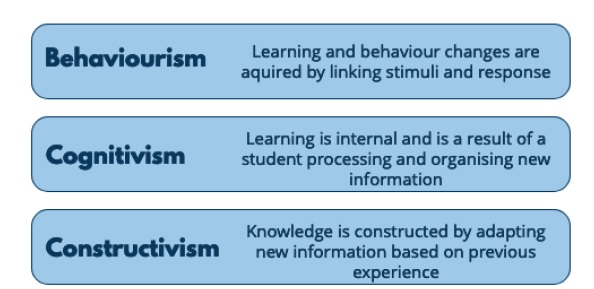(Please see full article for notes for each theories)
What are Learning Theories?
Swimming through treacle!
That’s what it feels like when you are trying to sort through and make sense of the vast amount
of learning theories we have at our disposal.
Way back in ancient Greece, the philosopher, Plato , first pondered the question “How does an
individual learn something new if the subject itself is new to them” (ok, so I’m paraphrasing, my
ancient Greek isn’t very good!).
Since Plato, many theorists have emerged, all with their different take on how students
learn. Learning theories are a set of principles that explain how best a student can
acquire, retain and recall new information.
In this complete summary, we will look at the work of the following learning theorists.
Click here Read more interesting case study based article on each TLS sub topic in my second website
1. Jean Piaget.
2. Lev Vygotsky.
3. Bloom’s Domains of Learning.
4. Gagne’s Conditions of Learning.
5. Jerome Bruner.
6. Maslow’s Hierarchy of Needs.
7. Howard Gardner’s Multiple Intelligences.
8. Erikson’s 8 Stages of Psychological Development.
9. Kolb’s Experiential Theory.
10. The Peter Principle.
11. Laird’s Sensory Theory.
12. Skinner’s Behaviourist Theory.
13. Roger’s Humanist Theory.
14. Canter’s Theory of Assertive Discipline.
15. Dreikur’s Classroom Management Theory.
Despite the fact there are so many educational theorists, there are three labels that they all fall
under. Behaviourism , Cognitivism and Constructivism

Behaviourism.
Behaviourism is based on the idea that knowledge is independent and on the exterior of the
learner. In a behaviourist’s mind, the learner is a blank slate that should be provided with the
information to be learnt.
Through this interaction, new associations are made and thus leaning occurs. Learning is
achieved when the provided stimulus changes behaviour. A non-educational example of this is
the work done by Pavlov .
Through his famous “salivating dog” experiment, Pavlov showed that a stimulus (in this case
ringing a bell every time he fed the dog) caused the dog to eventually start salivating when he
heard a bell ring.
The dog associated the bell ring with being provided with food so any time a bell was rung the
dog started salivating, it had learnt that the noise was a precursor to being fed.
I use a similar approach to classroom management.
I have taught my students that if I stand in a specific place in the classroom with my arms
folded, they know that I’m getting frustrated with the level of noise and they start to quieten
down or if I sit cross-legged on my desk, I’m about to say something important, supportive and
they should listen because it affects them directly.
Behaviourism involves repeated actions, verbal reinforcement and incentives to take part. It is
great for establishing rules, especially for behaviour management.
Cognitivism.
In contrast to behaviourism, cognitivism focuses on the idea that students process information
they receive rather than just responding to a stimulus, as with behaviourism.
There is still a behaviour change evident, but this is in response to thinking and processing
information.
Cognitive theories were developed in the early 1900s in Germany from Gestalt psychology by
Wolfgang Kohler. In English, Gestalt roughly translates to the organisation of something as a
whole, that is viewed as more than the sum of its individual parts.
In cognitivism theory, learning occurs when the student reorganises information, either by
finding new explanations or adapting old ones.
This is viewed as a change in knowledge and is stored in the memory rather than just being
viewed as a change in behaviour. Cognitive learning theories are mainly attributed to Jean
Piaget (see below).
Examples of how teachers can include cognitivism in their classroom include linking concepts
together, linking concepts to real world examples, discussions and problem solving.
Constructivism.
Constructivism is based on the premise that we construct learning new ideas based on our own
prior knowledge and experiences. Learning, therefore, is unique to the individual learner.
Students adapt their models of understanding either by reflecting on prior theories or resolving
misconceptions.
Students need to have a prior base of knowledge for constructivist approaches to be effective.
Bruner’s spiral curriculum (see below) is a great example of constructivism in action.
As students are constructing their own knowledge base, outcomes cannot always be
anticipated, therefore, the teacher should check and challenge misconceptions that may have
arisen. When consistent outcomes are required, a constructivist approach may not be the ideal
theory to use.

Click on the following links for full notes
- Piaget’s Theory of Cognitive Development.
- Vygotsky’s Theory of Learning.
- Bloom’s Domains of Learning.
- Gagné’s Conditions of Learning.
- Jerome Bruner.
- Maslow’s Hierarchy of Needs.
- Howard Gardner’s Multiple Intelligences.
- Erikson’s 8 Stages of Psychological Development.
- Kolb’s Experiential Theory.
- The Peter Principle.
- Laird’s Sensory Theory.
- Skinner’s Behaviourist Theory.
- Rogers’ Humanist Theory.
- Canter’s Theory of Assertive Discipline.
- Dreikur’s Classroom Management Theory.
